Abstract
Melatonin receptors were identified and characterized in crude membrane preparations from lizard brain by using 125I-labeled melatonin (125I-Mel), a potent melatonin agonist. 125I-Mel binding sites were saturable; Scatchard analysis revealed high-affinity and lower affinity binding sites, with apparent Kd of 2.3 +/- 1.0 x 10(-11) M and 2.06 +/- 0.43 x 10(-10) M, respectively. Binding was reversible and inhibited by melatonin and closely related analogs but not by serotonin or norepinephrine. Treatment of crude membranes with the nonhydrolyzable GTP analog guanosine 5'-[gamma-thio]triphosphate (GTP[gamma S]), significantly reduced the number of high-affinity receptors and increased the dissociation rate of 125I-Mel from its receptor. Furthermore, GTP[gamma S] treatment of ligand-receptor complexes solubilized by Triton X-100 also led to a rapid dissociation of 125I-Mel from solubilized ligand-receptor complexes. Gel filtration chromatography of solubilized ligand-receptor complexes revealed two major peaks of radio-activity corresponding to Mr greater than 400,000 and Mr ca. 110,000. This elution profile was markedly altered by pretreatment with GTP[gamma S] before solubilization; only the Mr 110,000 peak was present in GTP[gamma S]-pretreated membranes. The results strongly suggest that 125I-Mel binding sites in lizard brain are melatonin receptors, with agonist-promoted guanine nucleotide-binding protein (G protein) coupling and that the apparent molecular size of receptors uncoupled from G proteins is about 110,000.
Full text
PDF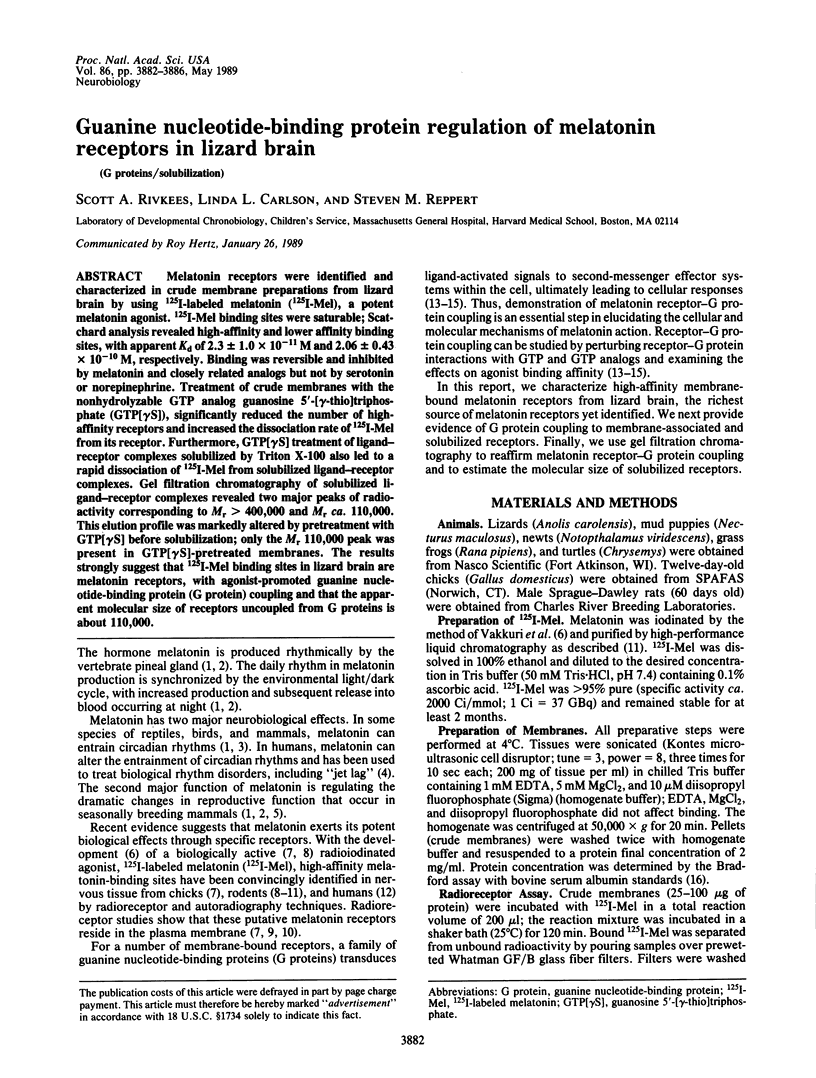
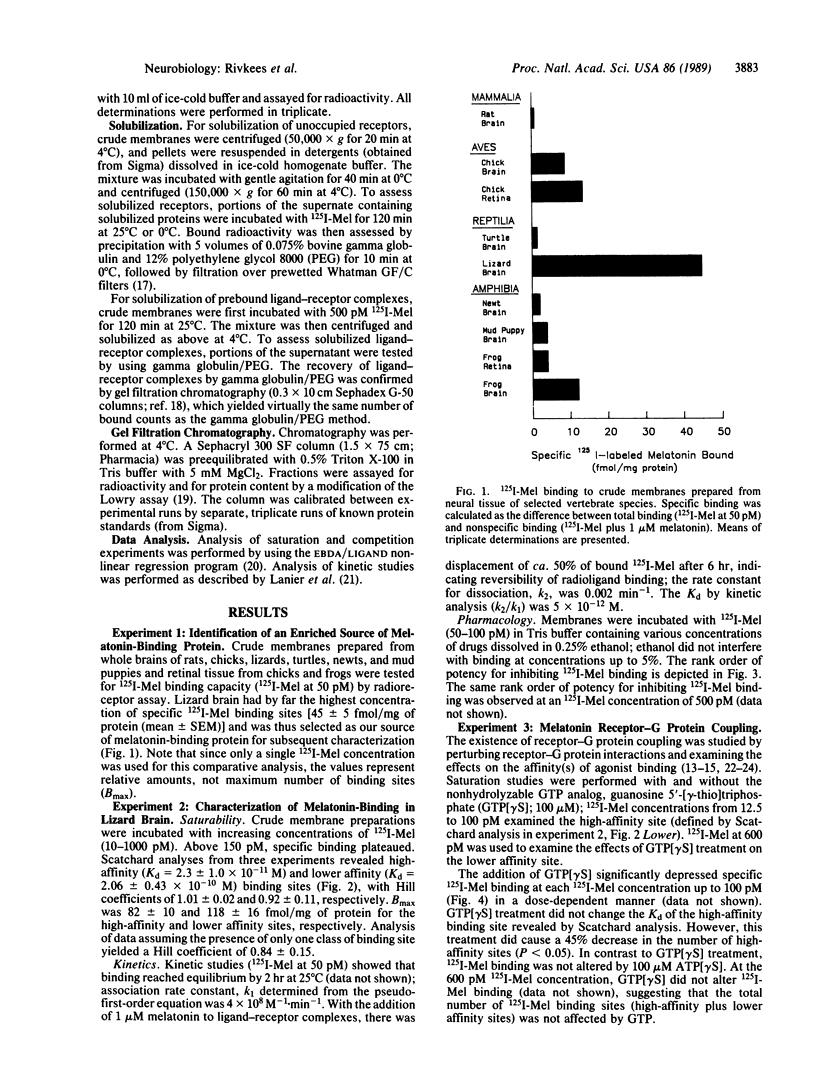
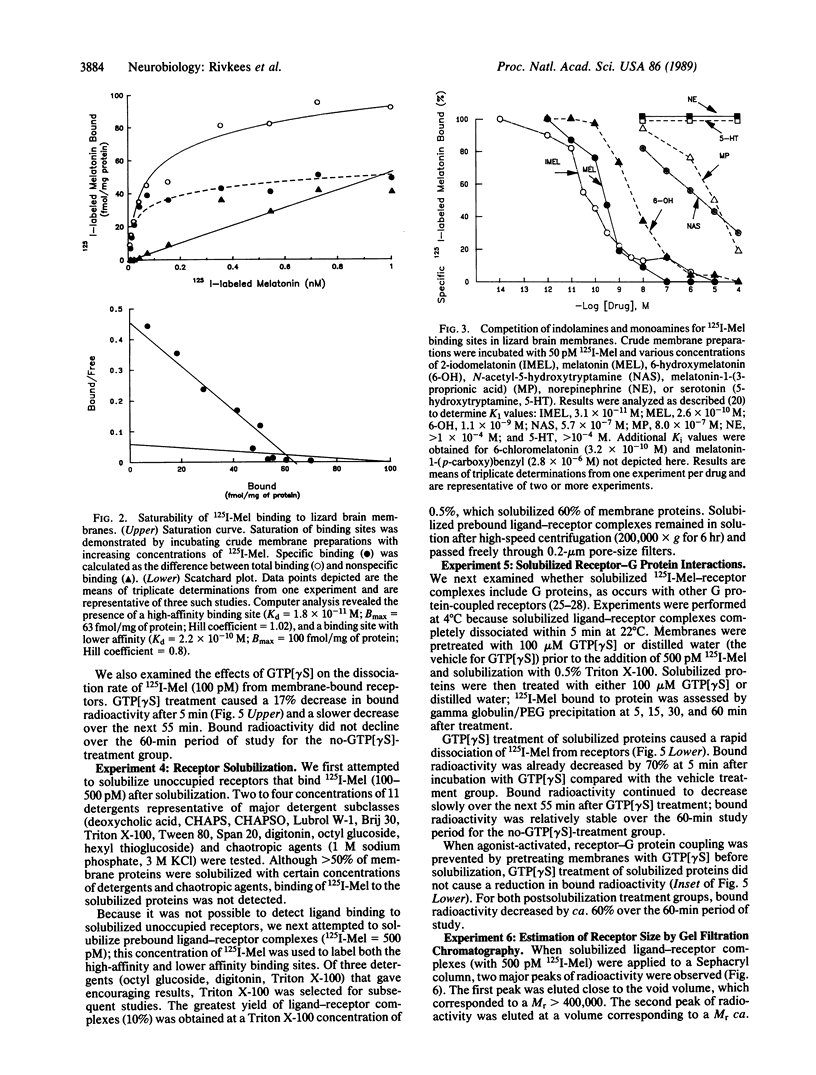
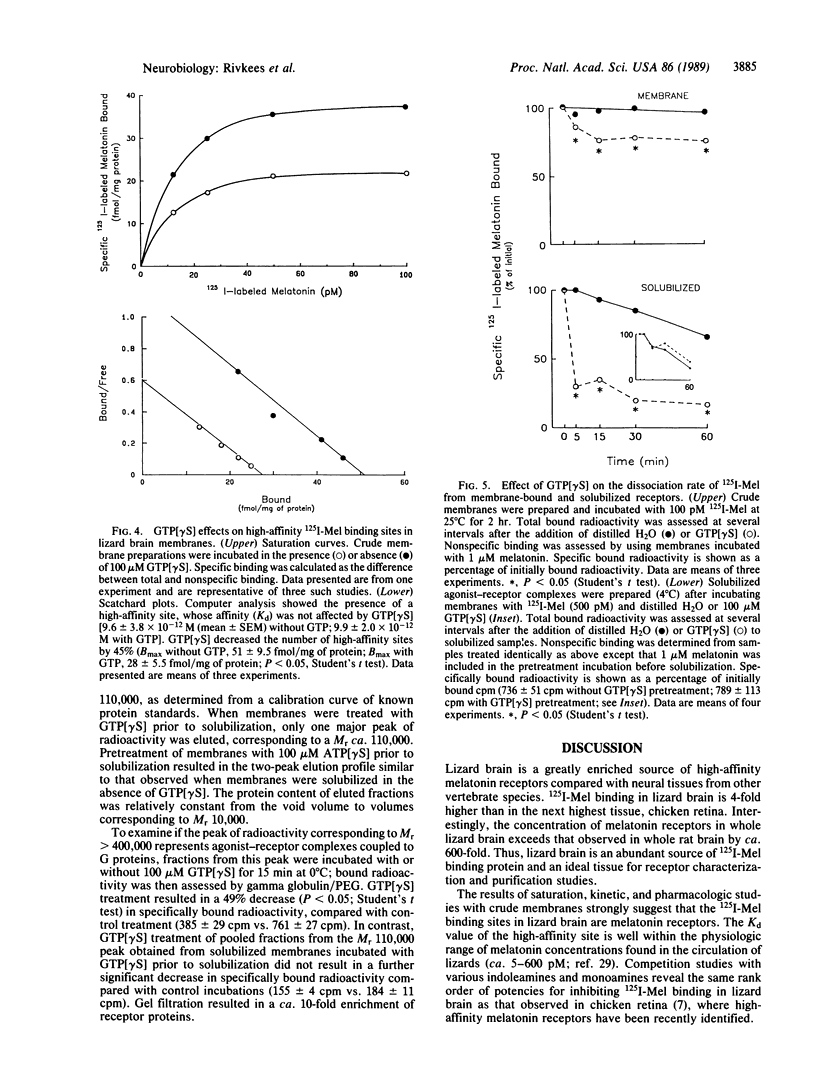
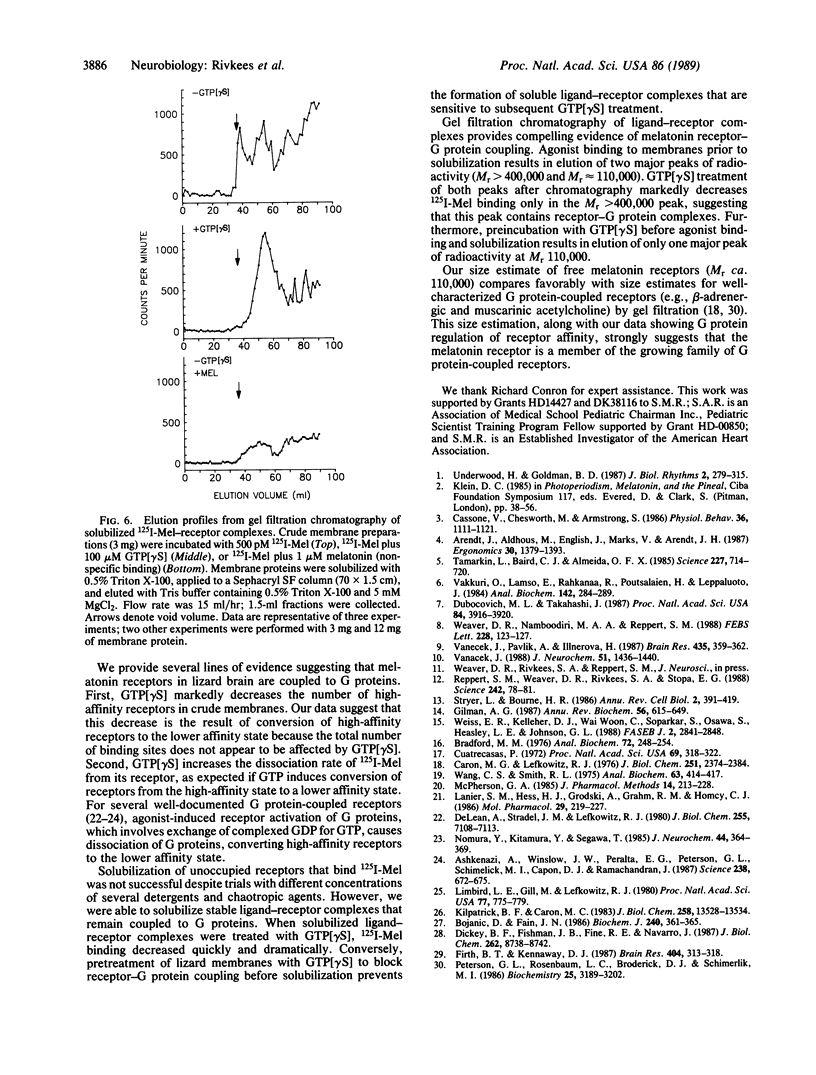
Selected References
These references are in PubMed. This may not be the complete list of references from this article.
- Ashkenazi A., Winslow J. W., Peralta E. G., Peterson G. L., Schimerlik M. I., Capon D. J., Ramachandran J. An M2 muscarinic receptor subtype coupled to both adenylyl cyclase and phosphoinositide turnover. Science. 1987 Oct 30;238(4827):672–675. doi: 10.1126/science.2823384. [DOI] [PubMed] [Google Scholar]
- Bojanic D., Fain J. N. Guanine nucleotide regulation of [3H]vasopressin binding to liver plasma membranes and solubilized receptors. Evidence for the involvement of a guanine nucleotide regulatory protein. Biochem J. 1986 Dec 1;240(2):361–365. doi: 10.1042/bj2400361. [DOI] [PMC free article] [PubMed] [Google Scholar]
- Bradford M. M. A rapid and sensitive method for the quantitation of microgram quantities of protein utilizing the principle of protein-dye binding. Anal Biochem. 1976 May 7;72:248–254. doi: 10.1016/0003-2697(76)90527-3. [DOI] [PubMed] [Google Scholar]
- Caron M. G., Lefkowitz R. J. Solubilization and characterization of the beta-adrenergic receptor binding sites of frog erythrocytes. J Biol Chem. 1976 Apr 25;251(8):2374–2384. [PubMed] [Google Scholar]
- Cassone V. M., Chesworth M. J., Armstrong S. M. Entrainment of rat circadian rhythms by daily injection of melatonin depends upon the hypothalamic suprachiasmatic nuclei. Physiol Behav. 1986;36(6):1111–1121. doi: 10.1016/0031-9384(86)90488-9. [DOI] [PubMed] [Google Scholar]
- Cuatrecasas P. Isolation of the insulin receptor of liver and fat-cell membranes (detergent-solubilized-( 125 I)insulin-polyethylene glycol precipitation-sephadex). Proc Natl Acad Sci U S A. 1972 Feb;69(2):318–322. doi: 10.1073/pnas.69.2.318. [DOI] [PMC free article] [PubMed] [Google Scholar]
- De Lean A., Stadel J. M., Lefkowitz R. J. A ternary complex model explains the agonist-specific binding properties of the adenylate cyclase-coupled beta-adrenergic receptor. J Biol Chem. 1980 Aug 10;255(15):7108–7117. [PubMed] [Google Scholar]
- Dickey B. F., Fishman J. B., Fine R. E., Navarro J. Reconstitution of the rat liver vasopressin receptor coupled to guanine nucleotide-binding proteins. J Biol Chem. 1987 Jun 25;262(18):8738–8742. [PubMed] [Google Scholar]
- Dubocovich M. L., Takahashi J. S. Use of 2-[125I]iodomelatonin to characterize melatonin binding sites in chicken retina. Proc Natl Acad Sci U S A. 1987 Jun;84(11):3916–3920. doi: 10.1073/pnas.84.11.3916. [DOI] [PMC free article] [PubMed] [Google Scholar]
- Firth B. T., Kennaway D. J. Melatonin content of the pineal, parietal eye and blood plasma of the lizard, Trachydosaurus rugosus: effect of constant and fluctuating temperature. Brain Res. 1987 Feb 24;404(1-2):313–318. doi: 10.1016/0006-8993(87)91385-0. [DOI] [PubMed] [Google Scholar]
- Gilman A. G. G proteins: transducers of receptor-generated signals. Annu Rev Biochem. 1987;56:615–649. doi: 10.1146/annurev.bi.56.070187.003151. [DOI] [PubMed] [Google Scholar]
- Kilpatrick B. F., Caron M. G. Agonist binding promotes a guanine nucleotide reversible increase in the apparent size of the bovine anterior pituitary dopamine receptors. J Biol Chem. 1983 Nov 25;258(22):13528–13534. [PubMed] [Google Scholar]
- Lanier S. M., Hess H. J., Grodski A., Graham R. M., Homcy C. J. Synthesis and characterization of a high affinity radioiodinated probe for the alpha 2-adrenergic receptor. Mol Pharmacol. 1986 Mar;29(3):219–227. [PubMed] [Google Scholar]
- Limbird L. E., Gill D. M., Lefkowitz R. J. Agonist-promoted coupling of the beta-adrenergic receptor with the guanine nucleotide regulatory protein of the adenylate cyclase system. Proc Natl Acad Sci U S A. 1980 Feb;77(2):775–779. doi: 10.1073/pnas.77.2.775. [DOI] [PMC free article] [PubMed] [Google Scholar]
- McPherson G. A. Analysis of radioligand binding experiments. A collection of computer programs for the IBM PC. J Pharmacol Methods. 1985 Nov;14(3):213–228. doi: 10.1016/0160-5402(85)90034-8. [DOI] [PubMed] [Google Scholar]
- Nomura Y., Kitamura Y., Segawa T. Decrease of clonidine binding affinity to alpha 2-adrenoceptor by ADP-ribosylation of 41,000-dalton proteins in rat cerebral cortical membranes by islet-activating protein. J Neurochem. 1985 Feb;44(2):364–369. doi: 10.1111/j.1471-4159.1985.tb05425.x. [DOI] [PubMed] [Google Scholar]
- Peterson G. L., Rosenbaum L. C., Broderick D. J., Schimerlik M. I. Physical properties of the purified cardiac muscarinic acetylcholine receptor. Biochemistry. 1986 Jun 3;25(11):3189–3202. doi: 10.1021/bi00359a017. [DOI] [PubMed] [Google Scholar]
- Reppert S. M., Weaver D. R., Rivkees S. A., Stopa E. G. Putative melatonin receptors in a human biological clock. Science. 1988 Oct 7;242(4875):78–81. doi: 10.1126/science.2845576. [DOI] [PubMed] [Google Scholar]
- Stryer L., Bourne H. R. G proteins: a family of signal transducers. Annu Rev Cell Biol. 1986;2:391–419. doi: 10.1146/annurev.cb.02.110186.002135. [DOI] [PubMed] [Google Scholar]
- Tamarkin L., Baird C. J., Almeida O. F. Melatonin: a coordinating signal for mammalian reproduction? Science. 1985 Feb 15;227(4688):714–720. doi: 10.1126/science.3881822. [DOI] [PubMed] [Google Scholar]
- Underwood H., Goldman B. D. Vertebrate circadian and photoperiodic systems: role of the pineal gland and melatonin. J Biol Rhythms. 1987 Winter;2(4):279–315. doi: 10.1177/074873048700200404. [DOI] [PubMed] [Google Scholar]
- Vakkuri O., Lämsä E., Rahkamaa E., Ruotsalainen H., Leppäluoto J. Iodinated melatonin: preparation and characterization of the molecular structure by mass and 1H NMR spectroscopy. Anal Biochem. 1984 Nov 1;142(2):284–289. doi: 10.1016/0003-2697(84)90466-4. [DOI] [PubMed] [Google Scholar]
- Vanecek J. Melatonin binding sites. J Neurochem. 1988 Nov;51(5):1436–1440. doi: 10.1111/j.1471-4159.1988.tb01108.x. [DOI] [PubMed] [Google Scholar]
- Vanecek J., Pavlík A., Illnerová H. Hypothalamic melatonin receptor sites revealed by autoradiography. Brain Res. 1987 Dec 1;435(1-2):359–362. doi: 10.1016/0006-8993(87)91625-8. [DOI] [PubMed] [Google Scholar]
- Wang C., Smith R. L. Lowry determination of protein in the presence of Triton X-100. Anal Biochem. 1975 Feb;63(2):414–417. doi: 10.1016/0003-2697(75)90363-2. [DOI] [PubMed] [Google Scholar]
- Weaver D. R., Namboodiri M. A., Reppert S. M. Iodinated melatonin mimics melatonin action and reveals discrete binding sites in fetal brain. FEBS Lett. 1988 Feb 8;228(1):123–127. doi: 10.1016/0014-5793(88)80599-4. [DOI] [PubMed] [Google Scholar]
- Weiss E. R., Kelleher D. J., Woon C. W., Soparkar S., Osawa S., Heasley L. E., Johnson G. L. Receptor activation of G proteins. FASEB J. 1988 Oct;2(13):2841–2848. doi: 10.1096/fasebj.2.13.3139484. [DOI] [PubMed] [Google Scholar]


